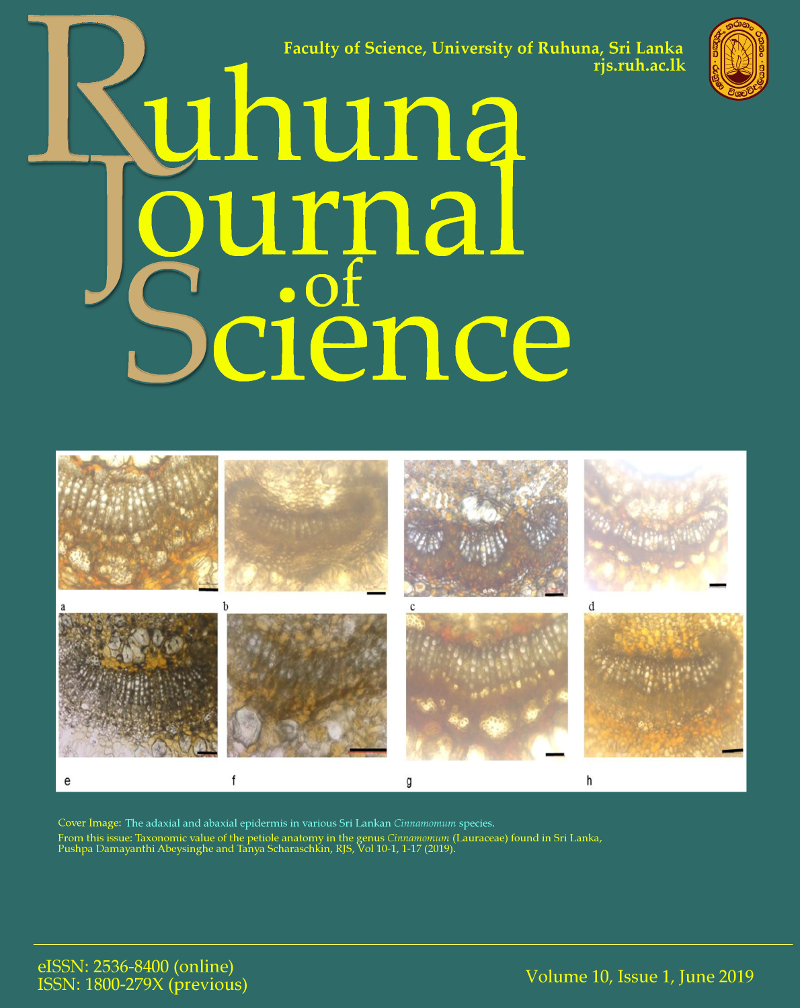Potential of cow dung as insect herbivore repellent on cow pea (Vigna unguiculata)
Abstract
This study examined the potential of using cow dung as a repellent of herbivore pest on cowpea (Vigna unguiculata) and the work was carried out in the botanical and zoological garden of the University of Lagos, Akoka, Lagos, Nigeria. Four accessions of cowpea were grown in the soil samples collected from the Botanical and Zoological garden of the University of Lagos. The experiment was arranged in a randomized block design with three replicates to monitor the potential of using cow dung as a repellent of herbivore pest on cowpea for a period of six weeks. The data collected was analyzed using ANOVA. The results showed that cow dung treatments did not have significant effect at (P> 0.05) in repelling the insect of cowpeas. However, the plants treated with high concentrations of cow dung attracted significantly (P<0.05) higher number of insect pests and as the days of the application of the treatments increases, the number of leaves damaged by the insects increases. This study therefore recommends that a further study should be carried out using some other different plants species at different locations and under different environmental conditions. Keywords: Cow dung, cowpea, insect repellentReferences
Ajeigbe HA, Singh B. 2006. Integrated pest management in cowpea: Effect of time and frequency of insecticide application on productivity. Crop Protection 25(9):920-925.
Atulesh 2011. Cow dung: A composted fertilizer. Retrieved from http://www.wealthywaste.com/ cow-dung-a-composted-fertilizer on September 9th, 20I8
Dolvo F, Williams C, Soaka L. 2014. Cowpea: Home preparation and use in West Africa. International Research Centre. Ottawa. 308pp.
Emosairue S, Eze D, Okore K. 2014. Timing of insecticidal application in Vignaunguiculata (L.) Walp and its potential as late season crop in Calabar area, Nigeria. Journal of Applied Chemistry and Agricultural Resources 8 (2): 6-12.
Mandavgane SA, Pattalwar VV, Kalambe AR. 2005. Development of cow dung based herbal mosquito repellent. Natural Product Radiance 4(4): 270-273.
Nampala P, Ogenga-Latigo MW, Kyamanywa S, Adipala E, Karungi J, Oyobo N, Obuo JE, Jackai LE. 1999. Integrated management of major field pests of cowpea in eastern Uganda. African Crop Science Journal. 7(4): 479-486.
Okogbue EC, Ojo BO. 2003. Local production of renewable energy (biogas) from animal waste for domestic and laboratory uses. Nigerian Journal of Solar Energy 14: 121-125.
Olatunde JA, Odebiyi J, Chaing HS, Jackai LN. 2013. Identification of sources of resistance in cowpea (Vigna unguiculata) L. Walp. to Clavigralla tomentosicollis stai (Hemipera, coreidae). Journal on Insecticide Application 2(4): 455-461.
Sawadogo A, Thio BB, Kiemde S, Drabo I, Dabire C, Ouedraogo J, Mullens TR, Ehlers JD, Roberts PA. 2009. Distribution and Prevalence of Parasitic Nematodes of Cowpea (Vigna unguiculata) in Bukina Faso. Journal of Nematology 41 (2): 120-127.
Sexena RC. 2010. Natural resistance of plant to pests: Roles of Allelochemicals. American Chemical Society. Washington D. C. 235pp.
UCANR (University of California, Agriculture and Natural resource). 2017. UC Pest management guidelines. Retrieved from ipm.ucanr.edu on 27th November 2018.
Tiroesele B, Sitwane M, Obopile M, Ullah MI, Ali S. 2017. Effects of effluent water on the abundance of cowpea insect pests. Environmental Monitoring and Assessment 189 (11): 1-10.
Downloads
Published
Issue
Section
License
From Volume 7 (2016) onwards, all articles published in Ruhuna Journal of Science are Open Access articles published under the Creative Commons CC BY-NC 4.0 International License. This License permits use, distribution and reproduction in any medium, provided the original work is properly cited and is not used for commercial purposes.
Copyright on any research article published in RJS is retained by the respective author(s).
Authors who publish with this journal agree to the following terms:
a) Authors retain copyright and grant the journal right of first publication with the work simultaneously licensed under a Creative Commons Attribution License CC-BY-NC 4.0 International, that allows others to share the work with an acknowledgement of the work's authorship and initial publication in this journal.
b) Authors are able to enter into separate, additional contractual arrangements for the non-exclusive distribution of the journal's published version of the work (e.g., post it to an institutional repository or publish it in a book), with an acknowledgement of its initial publication in this journal.
c) Authors are permitted and encouraged to post their work online (e.g., in institutional repositories or on their website) prior to and during the submission process, as it can lead to productive exchanges, as well as earlier and greater citation of published work (See The Effect of Open Access).

